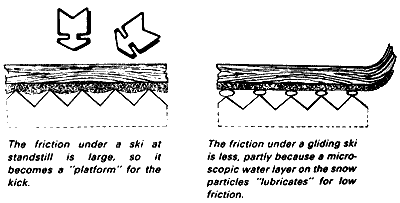Ski structure
Cross country skis are bent vertically. That allows for using different kind of wax depending whether person is sliding or kicking.
When buying skis, you should choose ones that are made for your mass. If they are for bigger person, skis will be less bendable, thus area of contact will be only on the ends. If they are for smaller person, skis will be unbent most of the time. That is not very good, because it would slow the person down. Ideally we want all the area of the ski to be in contact with the snow when pressure is applied and middle section off the snow when sliding.
 Figure 1. Waxing for the diagonal stride.
Figure 1. Waxing for the diagonal stride.
Friction is force dependant, meaning it changes depending on force applied.
Ff = F * μ
Glide wax is applied to the front and the end of the skies, this way when person removes force from one leg, friction becomes less and ski slides.
The ski is unbent when force is applied to it. Friction between snow and wax in the midsection increases so that it grips enough for a kick. Coefficient of static friction of the kick wax is only big enough for "the snow irregularities dig into wax irregularities just enough to give a motionless ski bite, or grip." (Brady)
At the moment when ski gains velocity, it is not at rest anymore, and since μk is less then μs, friction is not big enough to hold the ski. In some cases this friction converts enough energy to the heat to "melt a bit [of snow] to let ski slide on a microscopic water layer"(Brady) and thus even help to glide.

Figure 2. Picture from Ski Cross Country
Glide wax serve opposite purpose. It allows for skis to slide with as little friction as possible. It does that by filling and masking all irregularities on the ends of the skis. For the diagonal stride, glide waxing is not as important as kick waxing. If you ski couple times a week, doing hot waxing once every two month should be plenty. Kick waxing should be applied according to the temperature and it usually wears off in couple sessions.
Applying wax
It's the best to apply wax when you are still inside. This way wax and skis are warm and it is easier to put it on.
All flaky and dirty wax should be removed first. Glide wax is uniformly applied to the glide wax zones shown on the Figure 1. It can be done by melting it on the ski base and then spreading it with the scraper. All excessive wax needs to be removed.
Kick wax of the appropriate type is applied to the midsection with a simple crayoning-like motion and then evened out with the cork. This procedure takes less then 5 minutes.